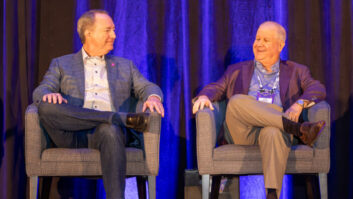CEDIA Product Introductions Focus on Aesthetics and Performance By Michael Heiss Legend has it that when he was once asked what colors his company’s cars came in, Henry Ford is said to have responded, “Any color you want, as long as it is black.” Anyone who has ever bought or dealt with the design of consumer electronics products, particularly would think that the same design theory holds true in the audio/video world. Variations on the theme of square black fronts, black buttons and blue displays have traditionally seemed to dominate the way products looked, regardless of brand or price point.
To some extent, that has been a good thing for the custom installer, as it opened the door to the type of “hidden” gear installation that has become a mainstay of many of our businesses. However, it must be noted that for every installation where the equipment is hidden there is another one where it is on view and out in the open. There, where the “anything as long as it is black” rule was once easy to apply, things are getting a bit tougher from a color palette standpoint. Leading that charge is the dramatic change in the way that display manufacturers have been styling their products in the past few years.
After all, “TV sets” (as we lovingly used to call them) spent many years in a black or dark cabinets once the wooden console was abandoned for the molded plastic shell. More recently, however, driven by the shift to flat front tubes, flat, thin PDP and LCD displays, and new designs in rear-projection televisions, a great deal of bright work has become popular in the industrial design and appearance for video displays of all types, sizes, technologies and brands.
It has taken a few years, but in the audio/video world is finally coming around to change their color and appearance outlook.
Admittedly, it is more than just an alteration in the appearance of displays that has caused this. One need look no further than the dramatic evolution in the appearance of “Home Theater in a Box,” or “HTIB” products that have peppered the market with systems that often make up for sonic and video performance deficiencies with striking design. Although there have always been bright-front products with natural aluminum front panels at the extreme high end of the audiophile and component world, the current trend toward something other than black has been given a big push by the silvery and mirrored fronts sported by many of the HTIB systems. Yes, looks do not compensate for performance, but you can’t ignore them.
Toward that end, one very interesting trend noted at the recent CEDIA EXPO was the appearance of new coloring for audio and DVD components.
As an example, Kenwood, NAD, Denon and Onkyo are offering A/V receivers with full “silver” front panels and top covers, while Harman Kardon has switched virtually its entire line to a combination of both black and silver, with matching silver/gray colored top covers. All of this is worth noting in the context of starting a quick overview of some of the more interesting trends to emerge from CEDIA EXPO 2003. The exterior of a product is what both you and the customer first see, and it is what the customer sees every day once the installation is completed. Yes, you need to match the industrial design of the product to the interior scheme of the room where the products live. However, you also must make certain that what is inside the product matches the client’s expectations as much as the front panel’s color blends in with the paint and carpet.
For example, let’s turn those products around and look at the back panels for a moment. There, the color is not important, but the types of connection points that appear are. A good example of this is the first widespread appearance of HDMI connectivity in a number of brands’ products. It is true that forward compatibility with the FCC’s “Plug ‘n Play” regulations, which was announced a few days after the EXPO ended, will easily be maintained for the large number of projectors and displays that now sport DVI/HDCP connectivity. This will insure that they will connect to the new wave of HDTV source components to appear over the next year without worries about disappearing down the “analog hole.” Moving further into the future, however, it seems like a sure bet that the smaller HDMI connector type will gradually supercede DVI.
Don’t worry too much about backward compatibility, as HDMI does add additional features such as audio and bi-directional control to the DVI video scheme, it should be interconnectable to existing DVI equipped displays through “dongle” style adaptors. Leading the way into the future with the smaller, more flexible HDMI jacks were projectors from Sony, Panasonic, Sim2 and Pioneer, LCD displays from Panasonic, plasma displays from Pioneer and Panasonic, DVD players from Meridian and Pioneer and processor/controllers from Meridian and Pioneer. This is one that has been talked about for a while, now it is finally here.
Not here, at least yet, are cable boxes, satellite receivers or HDTV tuners with HDMI. Nonetheless, another piece of the connectivity puzzle was tossed on the table at the EXPO. Perhaps anticipating the FCC rule-making decision, the trend toward products equipped with CableCard slots began in Indianapolis with the appearance of the first displays and set-tops that have this key feature. Formerly known as a Point of Deployment, or “POD” card, the newly renamed CableCards allow products with built-in digital cable-compatible QAM tuning to interoperate with the various conditional access platforms used by the cable industry under the Open Cable standards. Okay, let’s put that in simpler terms. With a CableCard-equipped product you won’t have to worry about connecting a cable box, because you won’t need one. The card allows the built-in tuner in a product such as the Panasonic RPTV to fully operate on any cable system and receive any programming, premium, pay or otherwise, for which that viewer is authorized. Alternatively, where a set top is required to feed an HDTV signal from a cable system to a “ready” product, having a CableCard slot means that you will be able to stock cable receivers and use them in almost any system, regardless of what company services the client.
If it seems as though the possibility of any of us every having the ability to legally sell cable boxes would remain a dream forever, the availability of CableCards is the answer to your prayers. A preview of that appeared at EXPO with a range of products from Motorola that are designed for retail sale and installation, including cable set-tops both with and without PVR capability, as a well as an updated version of their all-in-one A/V receiver that adds DVD-Audio and HD reception to the mix along with a CableCard.
Having solved a large part of the connectivity issue between existing DVI and 1394 connectivity and the HDMI and CableCards to come, another connectivity issue looks to be solved through the increased use of RS-232 ports on A/V receivers. While receivers offer a tempting combination of features that makes them suitable for custom systems, the lack of a standardized and easy-to-integrate means of control has often been lacking. The talents and ingenuity of installers have long been put to work with IR control, but that is often intermittent, and even in the best of installations it is only one-way. Perhaps seeing the light, an increasing number of brands have added bi-directional RS-232 control ports to their mainline products, making it easier to integrate a receiver to either a whole-house system or a single-room keypad or PC-based controller.
NAD, Marantz, Harman Kardon and Sherwood’s Newcastle line premiered RS-232-equipped receivers at EXPO, while Denon and Yahama added additional models to their existing serial communicative products.
Going one step further, one of the Newcastle receivers offers USB connectivity, as well. This feature may well come in handy over the next few months.
In related news, one of the other important announcements made in Indianapolis was the introduction of Dolby Labs’ new ProLogic IIx mode. As the “x” indicates, this is an extension of the existing ProLogic II processing and decoding technology, allowing 6.1 or 7.1 channel systems to offer discrete surround back channels from stereo or 5.1 channel programs. While the ProLogic IIx technology was demonstrated at CEDIA EXPO, most of the new receivers were not yet equipped to offer it. Thanks, however, to the use of the connectivity made possible by the RS-232 ports, it is likely that many models will take advantage of the serial ports to allow for the new modes to be added in-field at a later date.
Looking beyond rear panels and under the actual hoods of the new products at CEDIA EXPO, more technology trends began to reveal themselves. In the world of video displays, virtually all of the DLP-based products were in the process of upgrading to newer versions of the basic imaging chips or the sub-systems that drive them. All offer additional contrast along with other features, and given that the code names for these products tends to get slung around by consumers and sales people alike, it is worth decoding the mystery of the technology levels for those not on the inside. All three platforms use “M” words, with the Mercury-based products at the top.
Here, it isn’t the imaging chip itself that is new, but rather the driver chips that integrate the imagers with the rest of the projector’s video circuitry. Mercury-based systems are designed to make three-chip projectors more affordable, allowing greater light output and eliminating the need for color-wheel artifacts and noise.
All the major projection brands, including BARCO, Digital Projection International, InFocus, Marantz, Runco and SIM2 Multimedia are now on the Mercury bandwagon with products or prototypes.
“Mustang” is the description used for the highly popular HD-2 chip systems, offering 1280×720 resolution for full native HDTV displays.
Within the HD-2 offerings, Texas Instruments introduced a new, enhanced, “HD2+” version of the Mustang chip that offers increased color and brightness. If you are looking at a DLP based projector that is a single-chip 1280×720 model, it uses one version or another of the Mustang chips.
The third member of TI’s “M” trinity is the Matterhorn, a new 1024×576-resolution imager. It is not quite native HDTV, but it does allow full 16:9 images on the chip, as opposed to the earlier XGA models that did allow for all the resolution capability of the chip to be used when the system was configured for 16:9 images. This platform will enable higher performance at lower price points, with better resolution and contrast than current models. Given the popularity of DLP for fixed-pixel displays, this is certainly a technology trend to look for in projectors in all shapes and styles.
While the DLP steamroller barrels on in both the front and rear projection markets, don’t count LCoS and its derivatives out of the picture. Most notable in that technology area was the introduction of Sony’s long-awaited SXRD powered “Qualia D04” projector and the return of a D-ILA based engine to a rear projector from JVC. While the chips powering both of these models might be broadly categorized under the LCoS banner, their manufacturers claim significant unique differences that merit the unique monikers. The performance of both units is evidence that while some see LCoS in retreat, these sets along with Mitsubishi’s 84-inch-wide Alpha model should tell you that reports of LCoS’s death are very much exaggerated.
Elsewhere on the display trends front, a brief note must be made of the introduction of a new PDP panel size in the form of a 55-inch-wide unit produced by the FHP joint venture in Japan, and seen at EXPO under the Fujitsu brand. Exact availability and pricing were not announced, but this unique new size may hopefully give customer installers some relief from the competitive pressure being felt at retail by the appearance of lower cost HD-native 50-inch-wide panels.
There was much more to see at the largest CEDIA EXPO to date, but space does not permit a complete review here. We’ll get to more of those products over the months to come in category-oriented coverage, but looking back to the start of this article one final word is in order. When spec’ing products for a job you do need to start with a look at the front panel, as that is the continuing face of the job that your client will see. Fortunately, more choices for that side of the product are something that the manufacturers are beginning to make available to you. However, just as important, look at a product’s other faces, its back panel and the componentry inside to make certain that you have the right model for the job. Stick with that approach and you can’t go wrong.
Michael Heiss ([email protected]) is a technology and marketing consultant based in Los Angeles.







